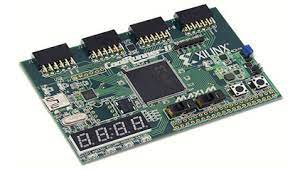
CPLD Tutorials for Beginners
September 11 2023 
Inquiry
Global electronic component supplier AMPHEO PTY LTD: Rich inventory for one-stop shopping. Inquire easily, and receive fast, customized solutions and quotes.
QUICK RFQ
ADD TO RFQ LIST
In this tutorial, we will learn about the basics of CPLDs and the CMOS Technology in it. We will also see the features and applications of CPLD.
What is CPLD?
Complex programmable logic devices (CPLDs) is one type of integrated circuit that application designers create to deploy digital hardware, such as mobile phones. These offer less logic than FPGAs (field programmable gate arrays), but they can handle designs with higher complexity than SPLDs (simple programmable logic devices).Each of the multiple logic blocks of CPLDs contains 8–16 macrocells. All of the macrocells in a logic block are fully connected because each logic block performs a distinct function. These blocks may or may not be connected to one another depending on their intended usage.
CPLDs Components
- Programmable logic array (PLA): The term "programmable logic array" (PLA) refers to a matrix of AND and OR gates that may be programmed to perform any logic operation.
- Macrocells: Macrocells are logic building blocks that come pre-configured and can be used to create standard operations like flip-flops, counters, and registers.
Microchip CPLD Architecture
A collection of programmable functional blocks (FBs) makes up a complicated programmable logic device. A GIM (global interconnection matrix) connects the inputs and outputs of various functional components. The contacts between the functional blocks can be changed thanks to the changeable nature of this connectivity matrix. A few input and output blocks will enable us to connect the CPLD to the outside world. The CPLD's architecture is displayed below. In general, a programmable FB resembles a set of logic gates, where a set of while gates can be altered while OR gates are reliable. To develop the functional block, each manufacturer, however, uses a different approach. Operating the feedback signals obtained from the outputs of the OR gates will reveal an o/p that is listed. After the code has been (simulated and synthesized, the design is initially programmed in Verilog or VHDL language in CPLD programming. The CPLD model (target device) is hand-selected during synthesis, and a technology-based mapping net list is created. Using a place and route procedure, which is normally accomplished by the place-and-route software of the CPLD Company's proprietary, this list can be closely matched to the actual CPLD design. The operator will then do a few confirmation procedures. He will use the CPLD if everything is in order; else, he will reorganize everything.CPLD Features
- Because CPLDs have a comparatively large number of gates, it is possible to implement devices and algorithms that are more complicated. In contrast to PALs, which typically have gates that range from a few hundred to over ten thousand, CPLDs have thousands to over ten thousand gates.
- CPLD logic is significantly more versatile and customizable than other types of logic because to special logic functions and intricately coupled feedback routes between the macro cells.
- After the machine has booted up, CPLD can begin running without the need for an external configuration memory. It belongs to the non-volatile configuration memory category.
- Electrically Erasable Programmable Read-Only Memory (EEPROM) is used by them.
- You don't have to be concerned about any unforeseen delays or memory loss because the CPLDs' non-volatile and non-ROM-based configuration takes care of both. Even after being turned off, the circuit retains the memory.
- Additionally, CPLDs are inexpensively and easily reprogrammable, which lowers your overall prices and expenses while also accelerating the time it takes for your products to reach the market.
- CPLDs fit perfectly in the majority of design processes and architecture thanks to their integrative and straightforward character, providing very little difficulty in terms of integration and design modifications.
- They require little upkeep, making them a long-term wise investment.
- CPLDs are a significantly more secure alternative because of their non-volatile nature, which makes it nearly impossible to steal the stored design. Although the user can employ encryption measures to counter this security danger, the external memory of the FPGA devices has the potential to reveal the IP.
- Because they have fewer interconnects than FPGAs, CPLDs are significantly better suited for deterministic timing analysis.
What are CPLDs used for?
CPLDs are used in a wide variety of applications, including:- Address decoders: Based on the address bus, address decoders are used to choose the proper memory location or peripheral device. They can be implemented using CPLDs.
- Protocol controllers: CPLDs can be used to create protocol controllers, which are used to regulate inter-device communication while a particular communication protocol is being employed.
- Traffic management functions: Implementing traffic management features in networks and routers, such as queuing and scheduling, can be done using CPLDs.
- State machines: State machines are used to govern the order of operations in a system, and they can be implemented using CPLDs.
- Arithmetic logic units (ALUs): ALUs are used to perform arithmetic operations such addition, subtraction, multiplication, and division. They can be implemented using CPLDs.
- Communication interfaces: To enable device communication, CPLDs can be used to construct communication interfaces, such as serial and parallel interfaces.
- Video processing: Scaling, filtering, and color correction are a few examples of the video processing tasks that can be carried out using CPLDs.
- Audio processing: Implementing audio processing features like equalization, compression, and filtering can be done using CPLDs.
- Control functions: Implementing control features such as motor control and temperature control can be done using CPLDs.
- Anti-lock braking systems (ABS): To prevent the wheels from locking up, CPLDs are employed in ABS systems to track the speed of each wheel and apply brake pressure to each one separately.
- Airbag control systems: To quickly detect a collision and deploy the airbags, CPLDs are employed in airbag control systems.
- Pacemakers: To monitor heart rate and provide electrical impulses to stimulate the heart to beat in a regular rhythm, CPLDs are used in pacemakers.
- MRI machines: CPLDs are used in MRI equipment to generate the images and manage the magnetic field.
- Oscilloscopes: To digitize the input signal and produce the display on the screen, CPLDs are used in oscilloscopes.
- Logic analyzers: CPLDs are employed in logic analyzers to record and examine digital signals.
CMOS Technology in CPLD
CMOS technology is commonly used in the production of CPLDs. Complementary metal-oxide semiconductors, or CMOS, are a type of semiconductor technology used to build logic circuits using both p-type and n-type transistors. The connection fabric and programmable logic elements (PLEs) of CPLDs are implemented using CMOS technology. The fundamental building blocks of logic that a CPLD uses to implement its digital logic functions are called PLEs. The wire network known as the interconnect fabric joins the PLEs to create the necessary logic circuit. The performance, power consumption, and cost-effectiveness of CPLDs have all improved because to advancements in the CMOS technology used in CPLDs. For instance, to achieve great performance and low power consumption, current CPLDs use sophisticated CMOS techniques including submicron CMOS and FinFET CMOS. Here are some specific examples of how CMOS technology is used in CPLDs:- PLEs: CMOS transistors are frequently used to implement PLEs in CPLDs. Because they can be set up to implement a wide range of logic operations, CMOS transistors are a good choice for this application.
- Interconnect fabric: CMOS multiplexers and pass gates are frequently used in CPLDs to implement the interconnect fabric. Because they provide for flexible and effective connections between the PLEs, CMOS multiplexers and pass gates are ideal for this function.
- Configuration memory: CMOS EEPROM cells are frequently used to implement the configuration memory in CPLDs. Because they are non-volatile and versatile, CMOS EEPROM cells are excellent choices for this function.
- CPLDs are mostly made possible by CMOS technology. The implementation of CPLDs is best accomplished using CMOS technology due to its low power consumption, high speed, scalability, and affordability.
How to get started with CPLDs?
The following are a few items you will need if you want to start using CPLDs:- A development board for CPLDs
- A cable for programming CPLDs
- CPLD programming software
Video related to How to Program a CPLD
CPLDs vs FPGAs
FPGAs have seen tremendous growth in recent years as a design tool for programmable digital systems. Between CPLD and FPGA, there are a lot of parallels as well as differences. Both programmable logic devices are made up of logic gate arrays, which is where the similarities end. With HDLs like Verilog HDL or VHDL, both devices are coded. The amount of gates is where CPLD and FPGA differ most significantly. A few thousand logic gates make up a CPLD, but millions of gates can be found in an FPGA. Consequently, utilizing FPGAs, complicated circuits and systems can be constructed. The drawback of this complexity is an increase in price. As a result, CPLDs are better suited for simpler applications. The fact that CPLDs have a non-volatile EEPROM (electrically erasable programmable random-access memory) built in whereas FPGAs have a volatile memory is another significant distinction between these two devices. As a result, unlike an FPGA, a CPLD can keep its contents even after it is turned off. A CPLD can also function right away after powering up thanks to built-in non-volatile memory. On the other hand, the majority of FPGAs need a bitstream from an external non-volatile memory to start up. Due to their extremely complicated architecture and user-specific programming, FPGAs exhibit unpredictable signal processing delays in terms of performance. The simplified architecture of CPLDs results in a substantially lower pin-to-pin delay. When designing embedded real-time and safety-critical applications, the signal processing latency is a crucial factor to take into account. Some FPGAs may use more power than CPLDs due to greater operating frequencies and more complicated logic operations. As a result, temperature management is crucial when designing systems using FPGAs. Because of this, FPGA-based systems frequently use heat sinks and cooling fans in addition to requiring larger, more intricate power supplies and distribution networks. Since the memory is integrated into the chip itself, CPLDs are safer from the perspective of information security. Contrarily, the majority of FPGAs call for external non-volatile memory, which poses a risk to data security. FPGAs contain data encryption techniques, but CPLDs are fundamentally more secure than FPGAs.Conclusion
CPLDs are a strong and adaptable tool for designing digital logic. You can start creating your own digital circuits and learning how to program CPLDs by referring to the advice and resources in this blog.Related Articles
- ·Stratix 10 VS Stratix V: Which FPGA is Right for Your Next Project?
- ·Intel Xeon Platinum 8454H vs AMD EPYC: Which Reigns Supreme?
- ·A Deep Dive into the AMD EPYC 4564P Processor
- ·MSP430F5438A vs MSP430F5529: A Detailed Analysis of Their Capabilities
- ·Comparing MSP430F6659 and MSP430F5419A: Which One is Right for Your Project?
- ·Exploring the Features of MSP430F5529 and MSP430F5638 Microcontrollers
- ·Demystifying 20 Microcontroller Projects for Beginners
- ·Unveiling the Ultimate Guide to Microcontroller Programming
- ·4680 Battery: Unveiling the Power Potential of the Next-Gen Cell
- ·Exploring the Case Studies on Arduino Applications
Populer Posts
S301030MAB2PZPR
Texas Instruments
R7F100GCH2DLA#AC0
Renesas Electronics America Inc
PIC32MX110F016D-V/ML
Microchip Technology
ATSAM3N1BB-MUR
Microchip Technology
R5F52315ADND#U0
Renesas Electronics America Inc
PIC12C671-10I/SM
Microchip Technology
C8051F818-GMR
Silicon Labs
MC68HC908LK24CFU
Motorola
DSPIC33FJ64MC802-H/MM
Microchip Technology
CY8C4126AZI-S423
Infineon Technologies
UPD78F0533AGK-GAJ-AX
Renesas Electronics Corporation
HD64F3694GFYV
Renesas Electronics Corporation
